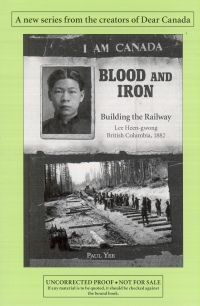| ________________
CM . . .
. Volume XVII Number 5. . . .October 1, 2010 
 |
Blood and Iron: Building the Railway. (I Am Canada).
Paul Yee.
Toronto, ON: Scholastic Canada, 2010.
234 pp., hardcover, $14.99.
ISBN 978-0-545-98593-2.
Subject Headings:
Chinese-Canada-History-Juvenile Literature.
Canadian Pacific Railway Company-History-Juvenile fiction.
Grades 5-10 / Ages 10-15.
Review by Diana Lynn Wilkes.
**1/2 /4
Reviewed from Uncorrected Proof.
|
| |
|

excerpt:
Last night Ba lost all his money, Poy Uncle said. The only way Ba could borrow money was to sign over his wages. Worse, Ba gambled away that loan too. Then he borrowed more money by signing over my wages. He lost that too. Now the only way we will have wages to take home is if Ba gambles more and wins enough to repay his loans.
My body went cold. If I could climb to the little porthole, I would throw myself off this ship. My muscles would be more useful as food for fish than as railway labour. What's the point of going to Canada if my wages don't go home to where they are needed? Grandfather will not regain the store. Ma will run out of household money. She will think of selling Little Brother again. Does Ba ever ponder her heartbreak?
I crawl back into bed. Unable to sleep, I pick up my pencil.
This new "I Am Canada" series showcases the defining moments of Canadian history experienced by young men just as the successful "Dear Canada" series portrays the remarkable adventures, dangers and hardships experienced by young women in early Canada. Also written by some of Canada's finest authors, the new series should become a similarly significant collection of meaningful, historical fiction for Canada's current young people.
This story, Blood and Iron, is written by Paul Yee, a renowned Chinese-Canadian author. As told through the journal writings of young Lee Heen-gwong, it describes the conditions and experiences for the Chinese immigrants working on the railway at locations along the Fraser River in British Columbia. Everything from overcrowding and seasickness aboard the trans-Pacific ship to backbreaking labour and blasting accidents in the railway tunnels, there were unbearable challenges to be faced. As gruesome as the situations may be, the inevitable gore and blood involved in the accidents (despite the title) are described with minimal detail (which may be disappointing to some readers!). Through all the trials and tribulations of living with his work crew and trying to please his Ba, Heen-gwong diligently records events of his year working on the railway in his journals before they are sent back to China.
The theme of the novel is excellent, and much research has gone into the writing. The novel captures the day-to-day events in the railway work camp, but, unfortunately, it lacks the unique details that create an authentic experience for the reader. Not only are sensory descriptions lacking for most events, but it is difficult to establish a strong sense of Heen-gwong, the journalist, through his factual writing style that is void of most emotion. Because there is not enough personal expression, the reader does not connect with the narrator particularly well and so does not experience the events as he might with more heart-felt writing.
Something that there is no shortage of is characters. Many names are given for people at home in China, on board the ship, in the first crew camp, the other one, town folk, "red beards," First Nations people, sites, etc. It is very difficult to keep track of who is who despite the use of nicknames such as Crew Boss, Pock Face, Thunder God, Bookman, Hot Water Wing, etc. Because little or no character development happens with most of them, the sheer volume of characters overwhelms and confuses instead of building the story.
As readers, young men may not be as concerned with rich character development as long as there's plenty of action. A plot driven story is usually what they are after, but here again the novel falls short. The plot is chronological and very linear. A variety of events take place that would be exciting but are written after the fact in the past tense without drama or suspense. The whole plot curve is not clear and missing much of the conflict and intensity that this fascinating situation and time in history could create. The ending comes so abruptly that it is unsatisfying.
The simplicity of the writing style would encourage most readers, reluctant or otherwise, and even those youth who are ESL but can read English.
Some excellent additions to this novel are the historical photos depicting Chinese railway workers, crew camps, and Fraser Canyon tunnels and bridges. They lend a truly authentic tone to this historical novel. As a supplemental resource to the Social Studies curriculum on Chinese Immigration (grade 5 in British Columbia), Blood and Iron would be an enriching aid to give some idea of how life might have been for the Chinese who came to British Columbia to take on the monumental task of building the railway. Paul Yee has found an interesting perspective in Lee Heen-gwong, and hopefully young readers will be able to engage in this remote character enough to enjoy and learn from the story.
Recommended with Reservations.
Diana Lynn Wilkes has taught grades Kindergarten to grade 7 and visual arts for grades 8-10. She holds a B.Ed from Simon Fraser University and a Master of Arts degree in Children's Literature from the University of British Columbia. She writes and paints from her homes in Surrey, BC, and Nelson, New Zealand.

To comment
on this title or this review, send mail to cm@umanitoba.ca.
Copyright © the Manitoba Library Association. Reproduction for personal
use is permitted only if this copyright notice is maintained. Any
other reproduction is prohibited without permission.
NEXT REVIEW |
TABLE OF CONTENTS FOR THIS ISSUE
- October 1, 2010.
AUTHORS |
TITLES |
MEDIA REVIEWS |
PROFILES |
BACK ISSUES |
SEARCH |
CMARCHIVE |
HOME |
